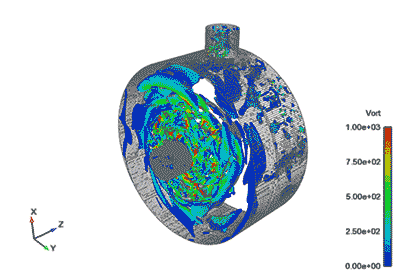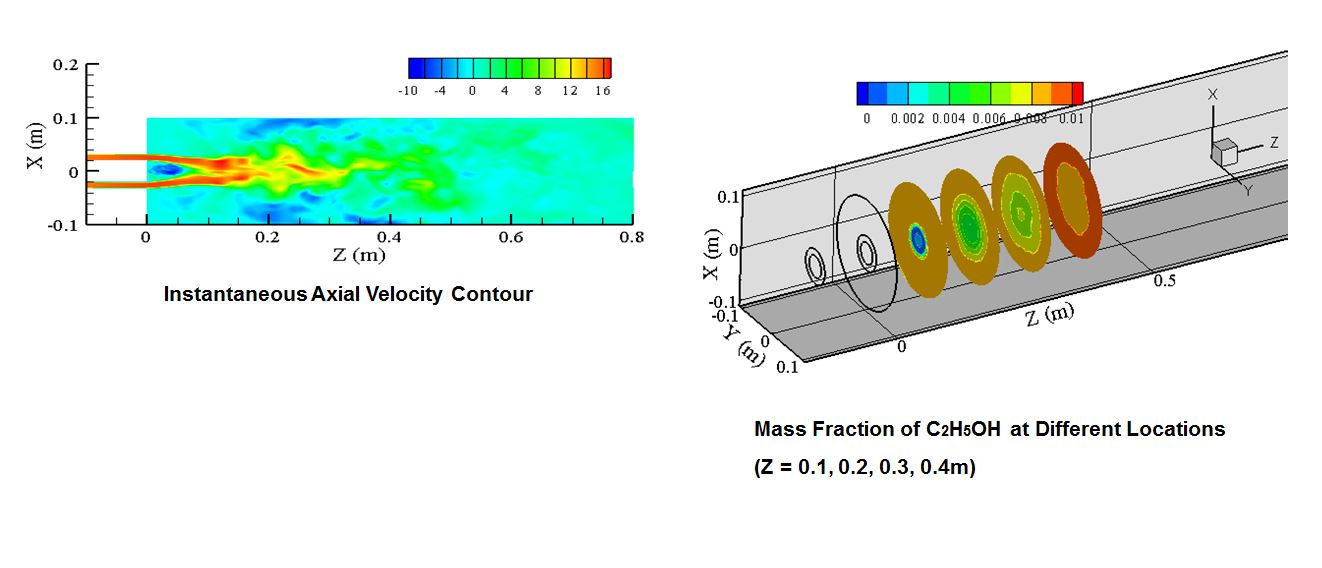
Our research
Thermal power and fluids engineering is a wide-ranging discipline covering the fields of heat transfer, thermodynamics, fluids mechanics and combustion. Below, you will find examples of recent research activities undertaken within the department:
Combustion modelling
As of 2017, the UK energy sector used nearly 200 Megatonnes of oil equivalent*. Of this, approximately 80% related to fossil-fuel combustion. Despite the imperative to decrease the UK’s overall dependence on fossil fuels, it is clear that the use of combustion as a prime mover remains essential to the wellbeing of the country and to the economy.
Combustion research in the school covers both premixed and non-premixed modes. As an example from the latter category, the figures below relate to the prediction of fire propagation (as well as attendant effects such as smoke and noxious product formation). This is highly relevant to safety case analyses in areas such as emergency evacuation and mitigation.
Key contact: Rob Prosser
*Department for Business, Energy and Industrial Strategy, UK Energy in Brief 2018

Buoyant plume fire simulation (calculations performed by M. Assad)
Fluid structure interactions (FSI)
This combined experimental and computational activity investigates situations in which the force exerted by a moving fluid on a structure can lead to rigid-body motion, elastic deformation or both.
Of particular interest are the unsteady FSI systems in which fluid motion can cause oscillatory motion. On the computational side, the aim is the development of an integrated fluid structure interaction solver, based on the finite-volume method. On the experimental side, the goal is to develop the capability to provide detailed local information of both surface motion and local flow fields.
Current and recent research projects on this topic include:
- The development of an integrated rigid-body unsteady FSI finite-volume solver, based on the use of sliding overset meshes.
- The experimental investigation of axial flow induced vibrations in PWR fuel rods, funded by EDF-Energy.
Key contacts: Hector Iacovides, Andrea Cioncolini, Alistair Revell
Numerical simulation demonstrating the use of a moving overset mesh to predict the vortex induced vibrations (VIV) exhibited by a circular cylinder when immersed within a flow.
High-fidelity turbulence modelling
This research activity has been led by Prof Laurence for the past 20 years. The objective is to improve the accuracy and versatility of high-fidelity but costly methods such as Direct Numerical Simulations and Large Eddy Simulations so their use can be extended to a wider range of industrial flows. Subsequently, these may be used to provide high-quality data to gain physical insight and validate less expensive and faster-to-run RANS models.
In the framework below, a dual mesh hybrid RANS-LES formulation is used to simulate flow in a differentially heated square cavity at high Rayleigh numbers. The use of drift terms as a source in the momentum equations of the RANS and LES solvers drives the solution towards the correct predictions.
Key contacts: Imran Afgan, Alistair Revell
Internal cooling flows of gas-turbine blades
This is a topic critical to continuing improvement in jet-engine efficiency and power, in which the Thermofluids group has developed a strong international reputation through a series of experimental and computational research projects.
A rotating water flow experimental facility – used with diagnostics techniques including laser-doppler anemometry, particle image velocimetry and thermo-chromic liquid crystals – makes it possible to provide detailed mappings of the dynamic and thermal fields of a variety of internal rotating cooling flows.
In parallel, the group has also introduced modelling innovations in the RANS computation of complex internal cooling flows, influenced by strong curvature, rotation, surface rib-roughness and impingement.
Current and recent research projects on this topic include:
- The RANS modelling of flow and heat transfer over dimpled surfaces.
Key contacts: Hector Iacovides, Tim Craft
Flow visualisation for impingement cooling passages
Modelling of complex non-Newtonian flows
Classical solids and liquids are usually differentiated in terms of their response to stress: a simple fluid is unable to support a shear stress without deformation, while a solid will not significantly deform until it yields.
A broad family of materials also exists between these two classical limits—the so called viscoelastic fluids—which exhibits characteristics of both solid and liquid simultaneously. Viscoelastic fluids are widespread; examples include blood, mining slurries and polymers. Understanding the constitutive response and performance of these fluids under general flow conditions remains an open problem.
Our research group is engaged in a number of projects aimed at understanding the effects of different constitutive models on process design and product performance. We are developing new models for the simulation of these fluids, along with the numerical techniques required to solve the resulting equations. The approaches being developed are aimed at many classes of constitutive behaviour, such as generalized Newtonian fluids (eg paints), emulsions (eg foodstuffs) or full viscoelastic models (eg polymer melts).
Key contact: Rob Prosser

Turbulent structures inside a high shear process mixer for a low internal phase emulsion (calculation performed by M. Assad)
Nuclear thermal hydraulics
The group has developed strong and long-standing experimental and computational research activities on this topic, in close collaboration with EDF-Energy and its UK precursors and more recently with BEIS, Rolls-Royce Nuclear, and Westinghouse. The research activities involve both experimental and computational investigations.
The former involves the use of a number of specialist facilities to provide insight and validation data in forced, mixed and natural convection flows, under conditions close to those found in nuclear reactors. The latter involves the use of high-fidelity turbulence models to generate detailed information to drive the validation process and also the assessment of existing RANS models and their further development for nuclear thermal hydraulics phenomena.
Current and recent research projects on this topic include:
- The investigation of the effectiveness of RANS models in the computations of cooling flows through fuel bundle channels.
- The simulation of passive cooling convection loops.
- The experimental investigation of PWR pressurisers.
- The experimental investigation of pressure losses in AGR fuel pin cooling passages.
Natural circulation loops (as in the animation below) are attractive to nuclear plant designers since they can be used to transport large amounts of thermal energy without the use of powered mechanical devices or human intervention. Optimising these systems using CFD can improve the passive safety of both current and future nuclear reactors.
Key contacts: Hector Iacovides, Andrea Cioncolini
Numerical simulation of a Natural Circulation Loop with a single heater and cooler. Buoyant interactions between the warmer and cooler fluid lead to complex local flow features and can even reverse the flow direction.
Power generation
Our researchers have wide-ranging experience in developing and implementing a variety of advanced algorithms in challenging fluid dynamics, heat and mass transfer problems in industry and academia, primarily in the energy conversion/propulsion and thermal manufacturing/processing industries.
The group has expertise in the development and application of advanced turbulence modelling, submodels for two-phase flow, coal and oil combustion modelling, and radiation and heat transfer analysis. We have also developed advanced computational techniques and algorithms (spectral element, high-order finite volume) and applications for the simulation of laminar, turbulent, non/reacting, multi-species, multi-phase flows in engineering configurations.
The group has obtained substantial external research and development funding and managed a variety of modelling studies for major gas turbine manufacturers including NASA, the US Department of Defense and Department of Energy, plus collaborations with a number of other commercial and governmental research groups in the US, UK and EU.
Key contact: Ali Turan

RANS Turbulence Modelling
The group has a strong international reputation in the development of mathematical models for the effects of turbulence on time-averaged flow and thermal fields, with the latter appropriately proposed by Osborne Reynolds, an activity led by Prof Launder since the 1980s.
The objective is to develop and validate mathematical models of turbulence which can result in accurate and fast simulations of turbulent flow and thermal processes in modelling software routinely used by industry.
Current and recent research projects on this topic include:
- Further refinements of advanced, analytical, wall-function strategies, which is a highly economical but traditionally also very approximate approach to the modelling of near-wall turbulence, to complex incompressible and also hypersonic flows.
- The adaptation of low-Re models of turbulence to hypersonic flows with shock-wave boundary layer interactions.
- The development a model of conjugate heat transfer for the penetration of the turbulence-induced thermal fluctuations into the solid wall.
- The validation of turbulence models in complex, unsteady 3-D flows:
– Past rotating cylinders
– Past rotating wind turbines
– In unstable thermal stratification subjected to magneto-hydrodynamic forces.
Key contacts: Brian Launder, Tim Craft, Alistair Revell
Simulation of Rayleigh-Benard natural convection cells, using a low-Reynolds-number stress transport model
Facilities
Discover more about our advanced experimental facilties in thermal hydraulics.
Opportunities
Find out about current research opportunities in Thermofluids and how to apply.

